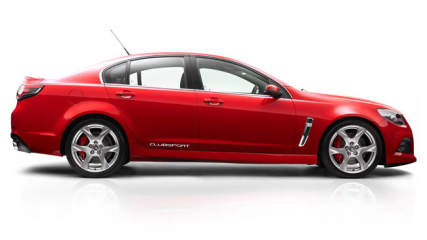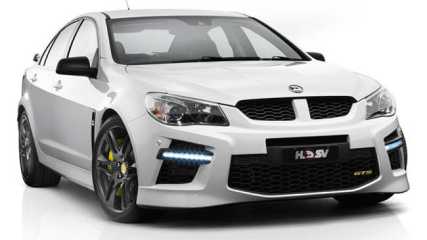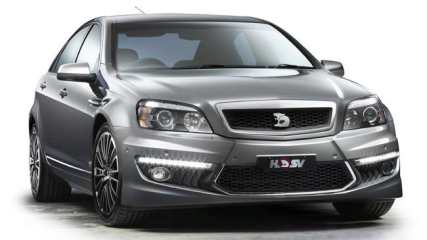HSV Grange 2010 News

HSV Gen-F fact files
Read the article
By Joshua Dowling · 15 May 2013
The HSV Gen-F project took 33 months from start to finish. As Holden began to finalise the VF Commodore in December 2009, HSV got into full swing once it was signed off by August 2010.
By December 2010 HSV had done the initial computer simulation testing on how an LSA engine would fit in the engine bay of a Commodore and what components would need to be strengthened.
The development of the Gen-F was the first time HSV had run to a General Motors timetable. In HSV's words, "we made the same decisions we used to make, but we made them earlier".
The new HSV range was tested in extreme hot and cold conditions, for durability testing and stability control settings, including Sweden, North America, Spain and outback Australia.
HSV tested Bridgestone and Continental tyres back to back during most of the VF development process. The company was reluctant to sever its loyalty to and its long ties with the Japanese tyre company. But test after test the Continental tyres delivered more grip, quicker lap times and performed better in all criteria.
The dial to adjust the driver settings in the GTS is from the Corvette, but with unique lettering for use in the HSV.
The water pump used on the engine is from the Holden Volt plug-in hybrid electric car.
HSV is expecting the weight and fuel consumption of most models to come down, but is yet to finalise figures. The GTS will likely be the same weight as before (or even a little heavier) given the heavy duty hardware added.
In transport mode (between Holden and HSV) the supercharged LSA engine is limited to 1500rpm so delivery drivers and other car wranglers can't thrash it.
This reporter is on Twitter: @JoshuaDowling

HSV Gen F range, the walk-up
Read the article
By Joshua Dowling · 15 May 2013
HSV MalooEngine: LS3 6.2-litre V8Power: 317kW and 550NmHighlights: Navigation, rear camera, front and rear parking sensors, self parking technology, blind zone alert, reverse traffic alert, sensor key with push button start (remote start available on automatic transmission), electric park brake, electric power steering, cloth seats, soft tonneau cover, SS sill covers. The rear bumper is new but the tailgate is the same as before. The 20-inch wheels are cast alloy painted silver. Maloo R8Engine: LS3 6.2-litre V8Power: 325kW and 550NmHighlights: Power increases to 325kW thanks to the fitment of a high-flow intermediate exhaust system and bi-modal mufflers. Gains leather seats with four-way electric adjustment for the driver, remote locking hard tonneau cover (redesigned with smaller humps and sail planes to improve rear visibility), sill covers unique to Maloo, plus EDI driver interface, forward collision alert, lane departure warning, heads-up display and rain sensing wipers. The 20-inch wheels (8.5-inch front and 9.5-inch rear) are cast alloy with a machined face and gloss black accents. Maloo R8 SVEngine: LS3 6.2-litre V8Power: 340kW and 570NmHighlights: The SV option includes a power and torque upgrade to 340kW and 570Nm, achieved through the addition of a bi-modal air intake system (borrowed from the Camaro), high-flow headers and catalytic converters, and a high-flow zip tube. The intermediate exhaust section and the bi-modal mufflers are the same as the R8. The 20-inch wheels (8.5-inch front and 9.5-inch rear) are forged alloy finished in graphite (borrowed from the 25th anniversary GTS). Matte black fender vents and mirror scalps. New “R8 SV” and “340” badges. ClubsportEngine: LS3 6.2-litre V8Power: 317kW and 550NmHighlights: Navigation, rear camera, front and rear parking sensors, self parking technology, blind zone alert, reverse traffic alert, sensor key with push button start (remote start available on automatic transmission), electric park brake, electric power steering, cloth seats. The 20-inch wheels (8.5-inch front and 9.5-inch rear) are cast alloy painted silver. Clubsport R8Engine: LS3 6.2-litre V8Power: 325kW and 550NmHighlights: Power increases to 325kW thanks to the fitment of a high-flow intermediate exhaust system and bi-modal mufflers. Has the same equipment as the Clubsport but gains leather seats with four-way electric adjustment for the driver, Bose sound (sedan only), EDI driver interface, forward collision alert, lane departure warning, heads-up display and rain sensing wipers. The 20-inch wheels (8.5-inch front and 9.5-inch rear) are cast alloy with a machined face and gloss black accents. Clubsport R8 SVEngine: LS3 6.2-litre V8Power: 340kW and 570NmHighlights: The SV option includes a power and torque upgrade to 340kW and 570Nm, achieved through the addition of a bi-modal air intake system (borrowed from the Camaro), high-flow headers and catalytic converters, and a high-flow zip tube. The intermediate exhaust section and the bi-modal mufflers are the same as the R8. The 20-inch wheels (8.5-inch front and 9.5-inch rear) are forged alloy finished in graphite (borrowed from the 25th anniversary GTS). Matte black fender vents and mirror scalps. New “R8 SV” and “340” badges. HSV Senator SignatureEngine: LS3 6.2-litre V8Power: 340kW and 570NmHighlights: The Senator comes standard with the 340kW “SV” pack. Standard fare includes magnetically-controlled suspension, eight-way electric adjustment on the driver and front passenger seat, leather upholstery, nine-speaker Bose audio, navigation, rear camera, front and rear parking sensors, self parking technology, blind zone alert, reverse traffic alert, sensor key with push button start, remote start, electric park brake, electric power steering. Other highlights include EDI driver interface, forward collision alert, lane departure warning, heads-up display and rain sensing wipers. The charcoal 20-inch wheels (8.5-inch front and 9.5-inch rear) are made from forged alloy. The Senator’s front bumper is the same as the Clubsport and Maloo but a blank is put in during the manufacturing process to leave space for a unique grille. The rear bumper is the same as the rest of the sedan range. HSV GrangeEngine: LS3 6.2-litre V8Power: 340kW and 570NmHighlights: The Grange comes standard with the 340kW “SV” pack. Standard fare includes magnetically-controlled suspension, eight-way electric adjustment on the driver and front passenger seat, leather upholstery, nine-speaker Bose audio, navigation, rear camera, front and rear parking sensors, self parking technology, blind zone alert, reverse traffic alert, sensor key with push button start, remote start, electric park brake, electric power steering. Other highlights include EDI driver interface, forward collision alert, lane departure warning, heads-up display and rain sensing wipers. The charcoal 20-inch wheels (8.5-inch front and 9.5-inch rear) are made from forged alloy. The front and rear bumpers are unchanged from the previous model because HSV doesn’t sell enough to justify the investment for new facias. HSV GTSEngine: LSA supercharged 6.2-litre V8Power: 430kW and 740NmHighlights: The HSV GTS gets the LSA engine from the Camaro ZL1, with heavy duty transmission, differential and axles fitted on the production line at Elizabeth, South Australia. Six-piston front brakes and four-piston rears (with two piece rotors and top-hat) are standard. Other highlights include magnetically-controlled suspension, eight-way electric adjustment on the driver and front passenger seat, leather upholstery, nine-speaker Bose audio, navigation, rear camera, front and rear parking sensors, self parking technology, blind zone alert, reverse traffic alert, sensor key with push button start, remote start (on automatic models), electric park brake, electric power steering, EDI driver interface, forward collision alert, lane departure warning, heads-up display and rain sensing wipers. The charcoal 20-inch wheels (8.5-inch front and 9.5-inch rear) are made from forged alloy. The GTS 25th anniversary wheels are a no-cost option. The only other option is a sunroof and red accented leather. This reporter is on Twitter: @JoshuaDowling

HSV GTS off to a flying start
Read the article
By Joshua Dowling · 15 May 2013
The new HSV GTS has become the fastest-selling model in the company’s 25-year history -- before the first one has even arrived at dealerships and before buyers even know the price.
HSV dealers across Australia are holding more than 150 paid deposits for the Commodore powered by a supercharged V8 borrowed from a racing version of the US Chevrolet Camaro. The early orders came in based purely on speculation about the new model, but this year’s allocation of GTS sedans is likely to sell out quickly now that official photos -- but not price -- have been released.
The new HSV GTS is expected to start at about $95,000 plus on-road costs, making it the second most-expensive Holden Commodore in the past 10 years (after the limited edition HSV W427 sold for $155,500 in 2008 and 2009). The last time a HSV GTS cost close to $100,000 was the Callaway V8-powered version from 2003, with an RRP of $97,500.
“This is the biggest response we’ve had for any HSV launch in our history,” said HSV director of sales and marketing boss Tim Jackson. “We’ve genuinely been overwhelmed by the reaction.” HSV GTS customers will need to be patient, however. Although the Clubsport, Maloo, Senator and Grange are due in showrooms in July, the first HSV GTS sedans are not due until late September.
As exclusively revealed by News Limited last month, the new HSV GTS will have 430kW of power and 740Nm of torque, making it the most powerful family sedan on sale in Australia until the new Mercedes-Benz E63 AMG arrives later in the year. But the HSV GTS will outgun its European rivals on price, most of which cost in excess of $200,000.
HSV is yet to publish acceleration times for the new GTS, but it is expected to reach 100km/h in less than 4.5 seconds. Top speed is electronically limited to 250km/h, as per General Motors’ global guidelines.
The HSV GTS also has the biggest brakes of any Australian-made production car: two-piece 390mm discs with six-piston calipers up front and two-piece 372mm discs with four-piston calipers on the rear (up from 378mm and 350mm respectively). The tech-heads may also like to know the front discs have 72 cooling vains (the same as a V8 Supercar), up from 48 with the old model.
The rest of the HSV range has four-piston forged calipers and 367mm discs front and rear. In a major leap for the Clubsport, Maloo, Senator and Grange, they now have bigger rear brakes than the front brakes of the previous model (365mm and 350mm).
The HSV GTS will earn notoriety for its epic power but it is also loaded with advancements, including a “torque vectoring” cornering control system inspired by Porsche and McLaren, and suspension technology also used by Ferrari.
Top models will come with a heads-up display that reflects vehicle speed and other key data into the windscreen in the driver’s line of sight, similar to that used by BMW. HSV cars also retain Holden’s self parking technology, standard across the new VF Commodore range.
Social media reaction to spy photos has centred on the more conservative design of the HSV Gen-F range. HSV says it wanted to create a classier looking range, and make it more aerodynamic. To that end it used the wind tunnel at Monash University to develop the front bumper bars and rear wings. The result: 0.358cD for the Clubsport (which has a more modest rear wing) and 0.365cD for the GTS. These are not numbers likely to win fuel economy challenges but better than they were before.
The GTS has a gaping mouth because HSV had to guarantee General Motors’ powertrain bosses in Detroit that it would be able to feed enough air to the LSA supercharged V8 engine to keep it cool on hot days. GM demanded 128,000mm2 of air flow but HSV delivered 130,000mm2 after testing the car extensively in the Australian outback in the peak of summer (The previous HSV E2 had 74,000mm2 of air flow through its front bumper). HSV even made the new GTS grille mesh thinner and removed the foglights to allow the LSA engine to breathe better.
To handle the epic grunt, the GTS is equipped with heavy duty automatic and manual transmissions (the latter with a double-plate clutch) and a massive 9.9-inch differential with cooling fins. The whole unit is about the size of an outboard boat motor.
To give the HSV GTS enough ground clearance for the differential, it has fitted a slightly taller profile of tyre across the range: 255/35 up front and 275/35 at the rear (compared to 245/35 and 275/30 before). HSV has ended its 25-year relationship with Japanese tyre maker Bridgestone and switched to a high performance European Continental 5P tyre that was originally developed for Mercedes-Benz.
While the big news is the supercharged 6.2-litre V8 GTS, the rest of the HSV range retains the Corvette-sourced 6.2-litre V8 from the previous generation (with the same outputs as before of 317kW and 325kW, depending on the model).
An option pack with 340kW of power and 570Nm of torque is available at extra cost on the Clubsport R8 and Maloo R8. Pricing, weight and fuel economy figures for each model are due later this month.
This reporter is on Twitter: @JoshuaDowling

HSV Grange E3 revealed
Read the article
By Paul Pottinger · 06 Sep 2010
The Enhanced Driver Interface is already confirmed for the HSV flagship, the WM3 Grange, and is expected to be standard across the E3. The EDI streams a dizzyingly variable array of real-time vehicle dynamics and performance data to a touch screen located in the centre console upper, taking a big step up and beyond the touch-screen console already fitted to Holden's own VEII Commodores.
The WM3 upgrade list also includes Side Blind Zone Alert, a bi-modal exhaust, reversing cameras, daytime running lights and satellite navigation. Power increases from 317kW to 325kW – the figure emblazoned on the Grange’s rear for the first time – and torque remains at 550Nm.
HSV says the V8 output will be unaffected by the major new option for the brand, its $5990 Liquid Propane Injection system. But it claims the propane system reduces emissions by up to 15 per cent and running costs by as much as 50 per cent.
While the hi-tech system is eligible for the Federal Government’s $2000 rebate on factory-fitted LPG systems, the Grange is still subject to a Luxury Car Tax hit.
While final prices will not be confirmed until the full 2011 HSV range is launched on September 21, HSV predicts $900 as the maximum increase. And HSV is confident the new Grange will continue to win sales from European brands.
“With the combination of the Grange’s power and new technologies we are confident the HSV Grange retains its position as the ultimate Australian-made luxury performance car,” says Darren Bowler, HSV’s general manager of sales. Our Grange buyer expects the best appointed car in our range, and with this much equipment as standard we are sure they won’t be disappointed.”
The seemingly-intuitive touchscreen EDI system was developed in conjunction with industry specialist MoTeC, which also supplies computer controls and digital dashboards to V8 Supercar teams. Its array of graphics and display pages was designed in-house by HSV’s styling department.
Modes include a stopwatch, data logging, corner G forces and dynamics.
A race page uses GPS to set tracks, record lap times, record fastest lap, as well as time gain and loss on individual laps. A number of circuits – including Bathurst and Phillip Island – are already programmed into the system.
While EDI is being touted as the HSV hero feature, the LPI is a new application of LPG to high performance motoring, injecting LPG into the cylinder as a liquid rather than vapour. This is said to allow for cooler combustion and better fuel metering, which in turn ensures outright engine performance can be maintained when it is incorporated as a dual-fuel system that, while delivering significantly reduced emissions and significantly lower running costs.
The WM3 also receives exterior and interior re-touches including a new front and rear design and daytime running lamps to bring luxury flagship into line with the rest of the HSV range.





